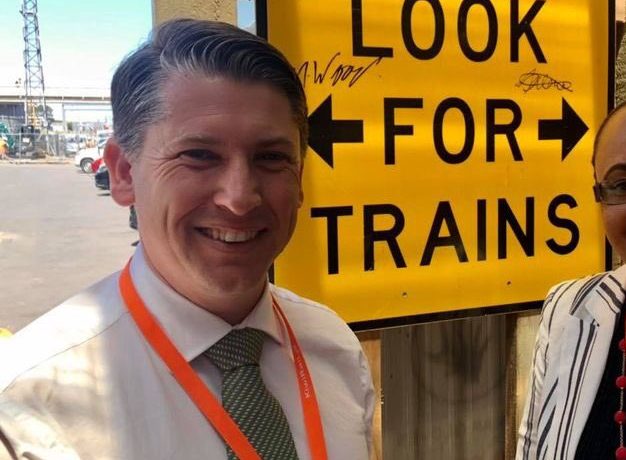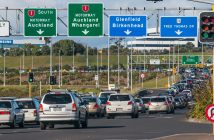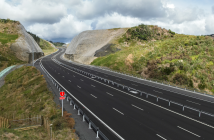The starting point has to be Mayor Robbie’s Rapid Rail scheme in the 1970s – Tāmaki Makaurau would be unrecognisable had the plan gone ahead, says Transport Minister Michael Wood
This was first posted on Greater Auckland pre-dating this week’s light rail announcement

Its failure was one of the key junctures that set us on a path of congestion, urban sprawl, and car dependency in the ensuing decades. It was of course quashed by the incoming Muldoon National government in 1975. Lacking central government support, it was simply unable to proceed.
Under Len Brown’s leadership, the new Auckland Council established in 2010 faced down an unwilling National government and secured shared funding for the CRL, but was unable to generate central government support for the Isthmus Light Rail network proposals it developed in the mid-part of that decade. The government of the day continued to fixate on a handful of mega-roading projects such as the East-West Link.
Finally, with Labour elected to government in 2017, central government was back at the table and with the Greens, two out of three government parties were keen to make mass rapid transit happen. The trouble, of course, was that in the end, the third party involved did not support the project proceeding. Complicating matters was the twin-track process. Conducted mainly as a commercial negotiation, it largely shut out Aucklanders, leading to a concurrent lack of support from local government.
For me as a Minister picking up the reins in 2020, and with a deep commitment to making Light Rail happen, the lesson from all of the above, is that if we are serious about this project then the leg work must be put into building a partnership between Auckland and Wellington. If either are not fully committed, a project of this scope and scale simply will not happen. That is why my focus this year has been on supporting a focussed, time-bound process to re-build relationships and broad consensus that light rail is needed for our city.
The Auckland Light Rail Establishment Unit has this focus built into its DNA. A unique governance structure involving elected representatives, community voices, mana whenua, central and local government agencies, and both transport and urban development officials have worked together to bring the project to this point, sharing perspectives, problem solving, and identifying issues that need further work. This work is about building a sustainable footing for the project after previous false starts.
The Chair’s Report and the work of the Establishment Unit
Most readers here will be familiar now with the Chair’s Report. It is a summary of the findings and Business Case developed by the Unit. It establishes the case for Light Rail investment, identifies the options, makes a recommendation, and provides advice about advancing the project from here.
Accompanying the report will be an Indicative Business Case for Light Rail. This is critical. Most of us have a ‘heart’ feeling for light rail. We’ve seen mass rapid transit of this kind work in other places. We know that when we have made investment in quality PT over the past 20 years that it has worked and created mode shifts. We can see a better future in which MRT acts as the lynchpin of an urban form that is more sustainable, nicer to live in, and supports community wellbeing. This is important, but the ‘head’ piece is essential too. The multi-billion investment that will be required has to stack up against the other calls for investment across transport and other parts of the public realm. This is where the IBC and the clear recommendations that stem from it are critical: ALR stacks up with a positive strategic, economic, and business case. All options deliver significant benefits including supporting up to 60,000 new houses along the corridor. Not only this, but ALR is a “necessary investment” that is required if Auckland is to meet a wide range of economic, social, and environmental challenges.
The Unit was told to investigate the key mode and route options for the corridor and to report back based on evidence and analysis. In response it has identified three options, all of which stack up and deliver significant benefits. Within those it has identified a preferred option, being “tunnelled light rail”. Broadly speaking the Unit sees this option as delivering most of the benefits of a full Light Metro system including greater long-term capacity and mode shift, higher urban development potential, and less construction disruption, but at a lower cost.

This preferred option has come under scrutiny from some in the Auckland urbanist community. People are of course entitled to their own view about the best way forward and I actually believe that good quality public debate is helpful. I would however ask people to step back a little from some of the heated rhetoric I have seen. The Establishment Unit is made up of skilled and committed people who want to see Light Rail proceed for Auckland. The governance board includes a diverse range of interests and perspectives, and officials working on the project have been drawn from both Waka Kotahi and Auckland Transport. We even provided the ability for any Board member who felt differently to express that view in the final report, which one person did.
In short, if the preferred option of the Unit is not yours, that isn’t evidence of a plot to undermine the project or embedded prejudices as has been suggested at times, it is simply that reasonable people looking at a complex problem can come to different views. Across all domains, each option has different trade-offs whether that is capacity, disruption, emissions profile (embedded and enabled), housing uplift, urban amenity, cost, and opportunity cost. The report transparently lists the clear trade-offs between options in a way that is not common before final political decision-making, and is an important part of providing transparency. Critically, I’d emphasise that our Government does not have a pre-determined view. We will carefully work through the options before making a decision, and even then, any preferred option will continue to be worked on and improved at the detailed design stage.
Key issues and options
Cost is clearly a significant consideration. Retro-fitting a significant MRT project into an existing city will always require a big investment. We face the situation of making or having to make a number of these investments in our major urban centres now because of a failure to invest over a fifty-year period. The fundamental choice in front of us now is whether we invest at a time when the problems – including congestion, sprawl, carbon emissions, and air pollution – are becoming acute, or do we kick the can to the next generation? Nor does putting off investment necessarily save money. If growth is not facilitated on this corridor, it will need to be supported elsewhere and will likely be more expensive if it occurs at the city fringes. Nonetheless, value for money is clearly important and this was added by the Government as one of the key objectives of ALR. Obtaining maximum value for money means that we are able to make our investment go further, and meet more of the needs. This will be a significant consideration for Cabinet.
It is also important to note that the City Centre–Māngere Light Rail is not a project that sits in isolation. It will connect into the existing public transport network and is the first stage of a linked up MRT network that will also include lines to the North Shore and the North West. Investment in the project delivers benefits not only to the immediate corridor, but enables the development of a network that will benefit huge numbers of Aucklanders in the future.

As such, consideration of an appropriate city centre interchange looms large. Significant capacity and space will be needed to enable a quality interchange that will handle far more passengers than the existing heavy rail network. This is significant in the Unit’s preference for an underground solution for the city centre. While there may be other solutions, we will carefully consider this issue so as not to cut off options and end up with a classic “four-lane Harbour Bridge” situation as we did in the 1950s.
At this point, it’s worth commenting briefly on our progress towards the Congestion Free Network first proposed by Greater Auckland, which has subsequently become the cornerstone of Labour’s policy for Auckland’s PT network. Progress is now being made on key connections right across the city:
- The CRL continues to make good progress and thanks to additional investment through ATAP 2021, it will be ready on Day 1 of operation to significantly increase network capacity.
- Interim improvements to the Northwest Busway are underway and commuters will see improvements by the end of 2022. Business case work into extending a dedicated PT corridor further from Westgate is underway.
- The Panmure to Pakuranga part of the Eastern Busway will shortly open with support from the Regional Fuel Tax.
- The Eastern Busway is now fully funded and the Pakuranga to Botany stage will move to construction next year.
- The electrification of the Papakura-Pukekohe line is funded, early works are underway, and full construction will commence over summer,
- Puhinui Station Interchange is open, with interim improvements to the Botany-Puhinui corridor funded within ATAP
- Planning is underway to increase capacity on the Northern Busway ahead of a PT-centred new harbour crossing.
I mention all of the above, because in the midst of big projects that take a long time to deliver, it is easy to forget the significant progress that has been made in recent years. The completion of the above projects and the ALR City Centre-Mangere line will deliver a substantial part of the CFN. Well done to everyone who has campaigned for it over the years!
Of all the issues on the table, the question of mode has probably generated the most comment, with strong proponents for both tunnelling and surface light rail. The specific trade-offs have been clearly articulated and I won’t repeat them here, but I will simply re-affirm that we will be heavily scrutinising all of them.
One issue that does bear comment is the debate about the extent of property acquisition built into the surface light rail route. An early claim that “500 properties will be acquired” has become somewhat embedded in dialogue about the issue. This stems from the Report which identifies that approximately 480 properties will be “affected”. This is a high level estimate of the number of properties affected (not necessarily outright acquired) by a ground level scheme, which almost unavoidably will be a higher number than for a tunnelled option – even if road widening is very limited. Road widening may be required at points, and does not mean that the project is building in acquisition to avoid any impact on vehicular traffic.
In fact, the surface light rail model will almost inevitably see all or most parking along the corridor removed. Widening at points may be required to facilitate high-quality accessible stations, cycle lanes (a key outcome we are building in) and nice wide pavements to cater for a higher urban population and busier town centres. Acquisition may also be important to drive and support some of the associated urban development that we want to see along the corridor. Ultimately, all of this will be refined during a comprehensive master-planning exercise at the next stage; running a firm ruler over assumptions will be important to ensure value for money.
Route is obviously a significant issue too. Mode largely determines the route through the central city and Isthmus. Surface Light Rail needs to follow the road corridor which is mainly a Queen St/Dominion Rd alignment. Tunnelling provides more flexibility, and would likely pick up the University Precinct, Kingsland, and the Sandringham corridor. Options around Mangere could vary and have been the subject of debate either way. Again, this is an issue we will look closely at but I do need to note that of all the communities the Unit engaged with, it was Mangere who spoke with the most unalloyed enthusiasm for the project, with a clear message that the local community has a strong aspiration for significant Light Rail-led urban renewal through their town centre. I have yet to be convinced that it would be equitable for the residents of inner Isthmus suburbs to have the convenience and opportunity of surface level Light Rail through their town centres, but not the people of Mangere.

Making it happen
Debate about all of these variations is good, and is not unexpected given the city-shaping nature of the proposal in front of us. I’m keeping my ears open, as are other Ministers. I would however encourage people who want to see MRT move forward for Auckland to remember that there is a war to be won, and not to solely focus on particular battles. At the outset I covered off the stymied history of Light Rail in Auckland. Making it happen will require unity and determination. The same regressive forces who argue against any progressive transport change are stirring once again, and will use their money and influence to try and stop change from happening. If you have a firm view about the options on the table then great, please let us know (no one seems to need too much encouragement) but please also get out there and help to sell the core case for Auckland Light Rail.
Forty-six years after small-minded thinking killed off Mayor Robbie’s Rapid Rail Plan, we have an historic opportunity in front of us. Here in Tamaki Makaurau we can create a world-class, linked-up mass transit system for our growing city. A connected congestion-free network with the CRL as the heart, and ALR as the spine, will open up public transport to hundreds of thousands people. It will create significant mode shift, cleaner air, and more opportunities for excellent walking and cycling connections. Well planned urban intensification along the route will provide more affordable housing for huge numbers of people, and easy access to shops, entertainment, education, and work. Lively town centres will become places that people want to visit instead of long-hauling to a mall on the other side of town. Diverse communities from inner city denizens to the people of Mangere will have their lives improved in many ways if we make this happen.
We know that this is what Aucklanders want, and I’m determined we’ll get there. There is much work ahead of us, but the firm base created by the Establishment Unit means that for the first time ever we have unity between central and local government to take the project forward. Mana whenua and community are at the table, and we have a solid business case to work from. There are many issues still to debate and work through, but if we can focus on the big goal here, we can make historic progress for Auckland. If you want to see Light Rail happen, then now’s the time to dig in and fight for it.







